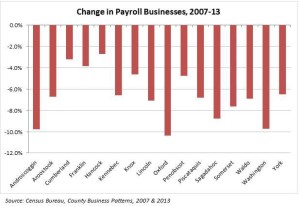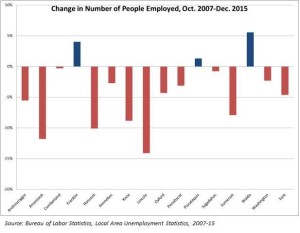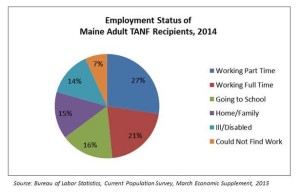LD 1631 reinforces federal standards that do not apply to the economic realities that Maine workers face. It makes it harder for individuals to get the skills they need to secure a better paying job, and undermines the ability of families to achieve economic security.
For a PDF of this testimony, click 1631-TANF and Work.
Good afternoon Senator Brakey, Representative Gattine, and members of the Health and Human Services Committee. My name is James Myall, and I am a policy analyst at the Maine Center for Economic Policy. I am here today to offer testimony in opposition to LD 1631.
Maine’s economic future hinges on our ability to boost the quantity and quality of our workforce and to assure that available jobs pay enough for workers to provide for their families. LD1631 is a step in the wrong direction. It reinforces federal standards that do not apply to the economic realities that Maine workers face. It makes it harder for individuals to get the skills they need to secure a better paying job, and undermine the ability of families to achieve economic security. As Maine continues on the road to economic recovery, we need all Mainers to be a part of that prosperity.
In February 2016, 5,300 adults received Temporary Assistance for Needy Families (TANF). That’s less than half of one percent of the state’s total population. The program costs approximately $350,000 a month, less than one tenth of one percent of monthly state spending.[i] While there are instances of fraud and abuse, they represent a small share of the overall program cost and have less impact on the state’s bottom-line than other forms of fraud – provider fraud and taxpayer fraud – associated with other programs. In trying to address these concerns, LD1631 unnecessarily rips the rug out from under thousands who abide by the rules and aren’t able to work because there still aren’t enough stable, full-time jobs available.
LD 1631 is predicated on the following assumptions:
- Maine faces a fine from the federal government.
- Maine parents receiving TANF are not working.
- There are no good excuses for not meeting the work requirement.
- Placing additional pressure on TANF recipients to find work will lead to better work rates.
Each of these assumptions is false. Recognizing that others will testify on the federal work requirement and on the value of programs like Parents as Scholars, I will focus my testimony on the economic aspects of the bill and the difficulties many TANF and non-TANF recipients have finding work in Maine’s lackluster economy.
Many parents receiving TANF are working. Of TANF’s 2014 recipients, almost 50% reported working in some capacity.[ii] However, the work participation rates assessed by the federal government do not take into account individuals working part-time, or seasonally. For many Mainers that remains an economic reality. Maine has one of the highest percentages of workers wanting full-time jobs but who are only able to secure part-time work.
That said, full time, year-round work remains hard to find for TANF and non-TANF recipients alike. Maine has yet to fully recover from the most recent recession. We have fewer jobs and fewer businesses now than we did in October 2007.[iii] Recognizing that existing work requirements remain difficult for states to meet, the Federal Department of Human Services allows states to obtain a waiver from these requirements. Given the part-time and seasonal nature of work in Maine, it makes more sense to request a federal waiver than to adopt federal work requirements. Doing so, will also make it easier administratively to implement TANF in Maine and does not undermine the value of efforts to connect program participants to jobs.
 This disappearance of jobs and small businesses is widespread. Thirteen of Maine’s sixteen counties have fewer people employed today than in 2007. Three-quarters of adult TANF recipients live in these areas. In 2013 (the most recent year with available data), every county had fewer businesses in operation than they did before the recession. The economic situation has likely recovered somewhat since then, but not enough to bring us back to 2007 levels.
This disappearance of jobs and small businesses is widespread. Thirteen of Maine’s sixteen counties have fewer people employed today than in 2007. Three-quarters of adult TANF recipients live in these areas. In 2013 (the most recent year with available data), every county had fewer businesses in operation than they did before the recession. The economic situation has likely recovered somewhat since then, but not enough to bring us back to 2007 levels.
 Furthermore, Maine’s unemployment rate is at a record low not because more people are working, but because the labor force has shrunk. The greatest decline in the workforce over the past few years has been among working age men, 25-45.[iv] These are individuals who have become discouraged looking for work, because none is available.
Furthermore, Maine’s unemployment rate is at a record low not because more people are working, but because the labor force has shrunk. The greatest decline in the workforce over the past few years has been among working age men, 25-45.[iv] These are individuals who have become discouraged looking for work, because none is available.
In addition to an inability to find work, TANF recipients who weren’t working in 2014 reported three major reasons – sickness, childcare, and going to school. Using education to improve one’s job prospects should be a priority for TANF recipients and the state. The elimination of the parents as scholars provision undermines this. Expecting parents to advance their education, maintain a job, and meet the needs of their family on limited income makes it less, not more likely, that parents and children will achieve greater economic security in the future. Furthermore, removing the “good cause” exemptions for work participation hurts those parents who are sick or disabled. A better alternative is to expand access to affordable healthcare and protect access to affordable and reliable childcare.
In closing, I’d like to reiterate a few key points. First, the evidence shows that TANF recipients are working, where they can, and that where they aren’t, it’s because they are attempting to improve their job prospects through education, or they are struggling with illness or to find reliable and affordable childcare. Second, a number of economic indicators clearly demonstrate that Maine’s economy has yet to return to pre-recession levels. Part-time and seasonal work remains a reality for many, but it doesn’t meet the federal work requirements. Even these jobs are hard to find in some areas, especially rural Maine, where the majority of TANF recipients live. As a result, it makes more sense for Maine to apply for a waiver of federal work requirements. Finally, nobody wants families to remain on assistance indefinitely, but the solution does not lie with the proposals in LD1631. Maine should be opening up pathways to education and retraining, removing barriers like the need to find childcare, and, most importantly, focusing on creating a better economy for all of us by adequately funding education and infrastructure that we all rely upon. Maine succeeds when all Mainers succeed.
Thank you. I’ll be happy to take any questions.
[i] Maine Department of Health & Human Services, Office of Family Independence data
[ii] Bureau of Labor Statistics, Current Population Survey, March Annual Economic Supplement, 2015
[iii] Census Bureau, 2010 & 2013 Zip Code Business Patterns; Economic Innovation Group, Distressed Communities Index; Bureau of Labor Statistics, Local Area Unemployment Statistics, October 2007-December 2015
[iv] Bureau of Labor Statistics, Current Population Survey, March Annual Economic Supplement, 2015




